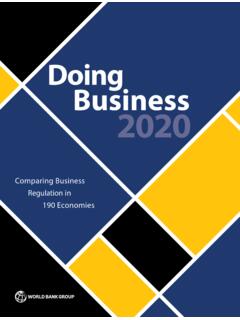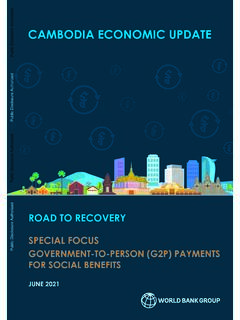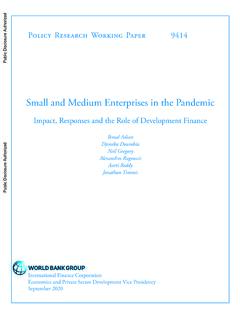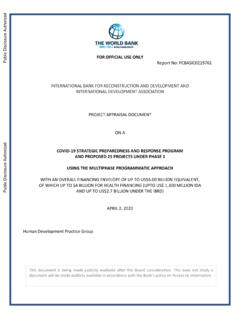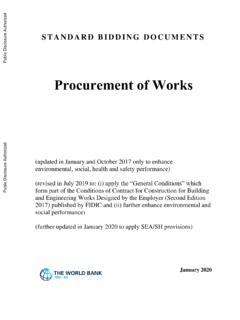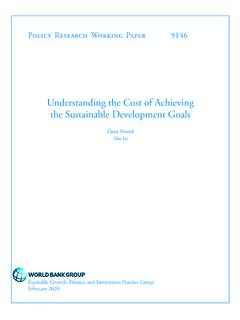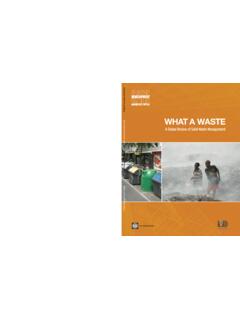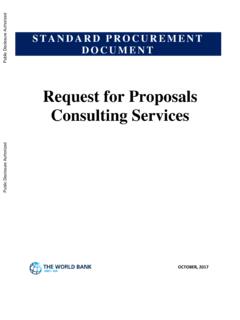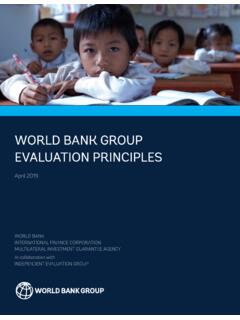Transcription of Public Disclosure Authorized Following the Government ...
1 Following the Government Playbook?Channeling Development Assistance for Health through Country SystemsMoritz Piatti-F nfkirchenAli HashimSarah AlkenbrackSrinivas Gurazada Public Disclosure AuthorizedPublic Disclosure AuthorizedPublic Disclosure AuthorizedPublic Disclosure AuthorizedFollowing the Government Playbook?Channeling Development Assistance for Health through Country Systems International bank for Reconstruction and Development / The world Bank1818 H Street NW, Washington DC 20433 Internet: ; Telephone: 202 473 1000 This work is a product of the staff of The world bank . The findings, interpretations, and conclusions expressed in this work do not necessarily reflect the views of the Executive Directors of The world bank or the governments that they represent. The world bank does not guarantee the accuracy of the data included in this work. The boundaries, colors, denominations, and other information shown on any map in this work do not imply any judgment on the part of The world bank concerning the legal status of any territory or the endorsement or acceptance of such boundaries.
2 Rights and PermissionsThe material in this work is subject to copyright. All queries on rights and licenses, including subsidiary rights, should be addressed to the world BankCover image - David LloydInternal photographs - Courtesy of the world bank Flickr libraryAbbreviations iiAcknowledgments iiiExecutive Summary iv1. Introduction 012. What Does Using Country Systems Mean? 073. Entry Points for Use of Country Systems 12 Strategic Planning and Prioritization 13 Budget Preparation and Financing 16 Budget Execution 19 Aligned banking arrangements 21 Aligned use of financial management information systems 23 Budget Evaluation 304. Developing a Reform Program 32 PFM Capacity and Fiduciary Concerns 33 Perception of PFM Capacity 34 Incentive Driving Use of Country Systems 345. Conclusions 37 References and Appendices 40 References 41 Appendix A.
3 The Aid Effectiveness Agenda: A Summary of Major Global Declarations 45 Appendix B. What Progress Has Been Made toward Using Country Systems? 47 Appendix C. Use of Country Systems in Tanzania 51 Appendix D. Development Partner Risk Factors Affecting Use of Country Systems across Select Development Partners 52 ContentsFollowing the Government Playbook? Channeling Development Assistance for Health through Country SystemsiCABRIC ollaborative African Budget InitiativeDAHD evelopment Assistance for HealthDPDevelopment partnerFMISF inancial Management Information SystemGaviGavi, the Vaccine AllianceGPEDCG lobal Partnership for Effective Development Co-operationMDGM illennium Development GoalsMTEFM edium-term expenditure frameworkNGON ongovernmental OrganizationOECDO rganisation for Economic Co-operation and DevelopmentPIUP roject Implementation UnitPFMpublic financial managementPEFAP ublic Expenditure and Financial AccountabilitySAIS upreme Audit InstitutionSDGS ustainable Development GoalsSPAS trategic Partnership with AfricaSWAP sectorwide approachTSAtreasury single accountUHCuniversal health coverageUNDPU nited Nations Development ProgrammeUNICEFU nited Nations Children s Agency for International DevelopmentWHOW orld Health OrganizationAbbreviationsiiSection Sub sectionAcknowledgmentsThis note was authored by staff from the world bank including Moritz Piatti-F nfkirchen (Senior Economist, Health, Nutrition and Population (HNP) Global Practice), Ali Hashim (Former Lead Treasury Systems Specialist, Governance Global Practice (GGP))
4 , Sarah Alkenbrack (Senior Health Economist, HNP), and Srinivas Gurazada (Global Lead, Public Financial Management, GGP). Excellent data analysis support was provided by Jewelwayne Salcedo Cain (Senior Consultant). This work is a global product that was produced under the leadership of Feng Zhao (Practice Manager for HNP Global Engagement Unit) and Christoph Kurowski (Global Lead for Health Financing). Outstanding editing was provided by Barbara Rice and graphic design by David Lloyd. Thoughtful peer review comments were provided by Toomas Palu (Advisor, HNP), Nang Mo Kham (Senior Health Specialist, HNP), Saw Young Min (Senior Governance Specialist, GGP), Maxwell Dapaah (Senior Financial Management Specialist, GGP) and Amir Aman Hagos (Senior Advisor, GFF). The work has benefited tremendously from feedback from an ongoing work program with Gavi to strengthen use of and alignment with country systems for channeling Gavi s health system strengthening support grants. The work also benefited from a coordination meeting of development partners hosted by the Global Financing Facility (GFF) and a dedicated session during the world bank Health Financing Flagship Course in November team also deeply appreciates expert guidance provided by Maxwell Dapaah (Senior Financial Management Specialist); Emiko Masaki (Senior Economist), Ziauddin Hyder (Senior Health Specialist); Hnin Pyne (Senior Health Specialist), Paul Jacob Ryan (Senior Health Specialist), Nang Mo Kham (Senior Health Specialist), Kent Ranson (Senior Health Economist), Amir Aman Hagos (Senior Advisor), Ellen van de Poel (senior health economist), Marion Jane Cross (Senior Health Economist), and Mariam Ally (Senior Health Economist).
5 The team has also benefitted tremendously from the collaborative work program with Gavi, and from joint dialogue on options for moving Gavi grants to country systems. The Gavi team includes Santiago Cornejo, Anthony Swan, Joe Martin, David Powell, Veronique Fages, and Breshna Orya as well as Vibhuti Hate (previously world bank and now Senior program manager, Gavi). Following the Government Playbook? Channeling Development Assistance for Health through Country SystemsiiiExecutive SummaryDevelopment partners (DPs) contribute to a significant share of total health financing, especially in low-income countries, and support the achievement of universal health coverage (UHC). However, if DP support is not well aligned with Government systems, it can lead to inefficiencies, such as poor prioritization, fragmentation, and duplication of activities, and inhibit the Government s ability to maintain effective stewardship over sector definition of Government systems is vague. Interpretation varies significantly from joining Government plans and putting financing into bank accounts of which the Government is co-signatory, to full use of the treasury single account (TSA) and Financial Management Information System (FMIS).
6 This note takes the perspective that Government should have full stewardship over all resources in the health sector, and DPs are aligned if their financing modality allows note develops a comprehensive interpretation of the term country systems in a Public financial management (PFM) environment along with a checklist across the budget cycle that can be used to assess whether DPs in a given country are aligned to various PFM aspects. Undertaking an assessment is expected to have the Following benefits: To provide a better understanding of the DP financial architecture and contribute to the literature of DP alignment and aid effectiveness. To articulate a clear baseline of DP financing modalities to allow for establishing a logical framework that will help articulate a reform program and strengthen mutual accountability. To foster learning across countries and practice, it may not always be possible for DPs to be fully aligned with Government PFM systems. However, identifying where they are on a spectrum rather than simply on system or off system may help the reform dialogue.
7 The assessment could be done by either DPs or recipient countries in order to establish a baseline, and serve as a basis for mutual accountability to strengthen aid effectiveness going Sub sectionIntroductionThe era of the Millennium Development Goals witnessed an unprecedented growth in development assistance for the health sector. From 2000 to 2010, development assistance for health (DAH) grew at 10 percent per year. While DAH amounted to $ billion in 2018, growth plateaued between 2010 and 2018 at percent annually (Dieleman et al. 2019). Even before the COVID-19 pandemic, most low- and middle-income countries were not on track to achieve universal health coverage by 2030. A 2019 report by the world bank group estimated that the financing gap to achieve UHC in 54 of the world s poorest countries was $176 billion per year (WBG 2019), but this amount has only increased with setbacks in coverage of essential services. Health expenditure data from 2017 suggest that 930 million people globally spent above 10 percent of their household budget on health care, and 210 million spent more than 25 percent, which is considered catastrophic (WHO 2019).
8 Many more forego care altogether or seek care of insufficient quality to improve health outcomes. These statistics are a rallying cry to make sure development assistance is designed and used as efficiently and effectively as possible to achieve country incomeLower middle incomeUpper middle income01020304050607080 External share of current healthexpenditure (%), 2018 2505001,0262,0003,9957,00012,500 GNI per capita (US$), 2018 Figure 1: External funding is more important for low-income countries (R2 = )Source: WHO Global Health Expenditure Database (2021); world Development Indicators (2021).02 Introduction In many low- and lower-middle-income countries, DAH plays an important role in helping countries make progress toward UHC. Funding from DPs can constitute an important source of revenue for financing health expenditures, which is estimated to cover more than half of total health expenditures for some countries. The relative importance of DAH is negatively correlated with a countries level of income (figure 1).
9 Adequate stewardship over DAH and the efficient use of these resources is therefore particularly important for countries where external resources make up a large share of the total financing DAH is delivered affects the ability of countries to achieve and sustain development outcomes. This subject has been extensively studied in the literature. Among other things, the proliferation and fragmentation of DPs was found to lead to inefficiencies arising from duplication of activities, implementing nonpriority activities, being slow to respond to emergencies, placing an unnecessary administrative burden on civil servants, creating an inequitable distribution of resources, and undermining Government service provision by pulling Government staff away from their day-to-day duties (Annen and Moers 2012; Vaillancourt 2009; Schulpen, Loman, and Kinsbergen 2011; Pallas and Ruger 2017; Piatti-F nfkirchen and Schneider 2018; Bourguignon and Sundberg 2007; Menocal and Mulley 2006; Leiderer 2012).
10 Some studies also make the link between use of country systems and improved health outcomes. For example, Piatti-F nfkirchen and Smets (2019) found that a one-unit increase in PFM quality reduces the U5 mortality rate with about 14 deaths per 1,000 live births. For countries that channel at least 75 percent of Public health expenditures through the Government system, this rate increases to 17 deaths per 1,000 child births. This result is consistent with Fujii (2018) who finds that Public health spending is equally effective as private health spending as long as the sector is well governed. Evidence from Ethiopia, Nigeria, and the State of Uttar Pradesh, India suggests that DP-funded innovations that respond to policy issues identified by the Government and that are aligned with Government priorities are more likely to be scaled up by governments, as compared to externally financed innovations that are conceptualized by DPs and use parallel systems (Wickremasinghe 2018).To expedite the ambitious goal of UHC and Sustainable Development Goal (SDG) 3, it is paramount to make best use of available resources.
